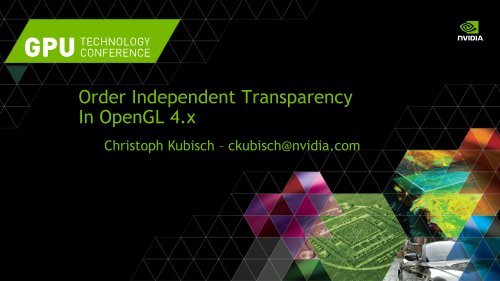S4385-order-independent-transparency-opengl
S4385-order-independent-transparency-opengl
S4385-order-independent-transparency-opengl
- No tags were found...
Create successful ePaper yourself
Turn your PDF publications into a flip-book with our unique Google optimized e-Paper software.
TRANSPARENT EFFECTS• Photorealism:– Glass, transmissive materials– Participating media (smoke...)– Simplification of hair rendering• Scientific Visualization– Reveal obscured objects– Show data in layers2
THE CHALLENGE• Blending Operator is not commutative• Front to Back• Back to Front– Sorting objects not sufficient– Sorting triangles not sufficient• Very costly, also many state changes• Need to sort „fragments“3
RENDERING APPROACHES• OpenGL 4.x allows various one- ortwo-pass variants• Previous high quality approaches– Stochastic Transparency [Enderton et al.]– Depth Peeling [Everitt]3 peellayers– Caveat: Multiple scene passesrequiredPeak ~84 layersmodel courtesy of PTC4
RESOLVE• Fullscreen pass– Not efficient to globally sortall fragments per pixel– Sort K nearest correctly viaregister array– Blend fullscreen on top offramebufferuvec2 fragments[K];// encodes color and depthn = load (fragments);sort (fragments,n);vec4 color = vec4(0);for (i < n) {blend (color, fragments[i]);}gl_FragColor = color;6
TAIL HANDLING• Tail Handling:– Discard Fragments > K– Blend below sortedand hope error is notobvious [Salvi et al.]• Many close low alphavalues are problematic• May not be framecoherent(flicker) ifblend is not primitive<strong>order</strong>edK = 4 K = 4TailblendK = 167
RECORD TECHNIQUES• Unbounded:– Record all fragments that fitin scratch buffer– Find & Sort K closest later+ fast record- slow resolve- out of memory issues8
HOW TO STORE• Unbounded:– Resize dynamically based on global countersof past frames (async readback)• Avoid glGetBufferData or glMap on counter buffer• Use a second dedicated „copy & read“ buffer– Consider Tiled Rendering Approach• Less overall memory consumption• Record & Resolve per Tile9
RECORD TECHNIQUES• Bounded:– Record K closestfragments– Sort K later- slower record+ fast resolve+ guaranteed min qualityK = 4 K = 1610
HOW TO STORE• Bounded:– Prefer „page“ memory layoutlistPos(i) = x + y * width + i * (width * height);11
APPROACHES• Single Pass– Simple (least correct)– Linked List (unbounded)– Spin Lock (not stable)– Atomic Loop 64-bit• Two Pass– Offset Array (unbounded)– Atomic Loop 32-bit12
SIMPLE• Record first K– Highly draw-<strong>order</strong> dependent– First != nearest– Tail blending not suitful• Sort & resolveUnsortedSortedSorted + TailDraw <strong>order</strong>:4 3 1 2K = 3K = 1613
SIMPLE• Recordlayout (early_fragment_tests) in;layout(rg32ui) uniform coherent uimageBuffer imgAbuffer;layout(r32ui) uniform coherent uimage2D imgCounter;...uint oldCounter = imageAtomicAdd (imgCounter, coord, 1u);if ( oldCounter < K ){imageStore ( imgAbuffer, listPos (oldCounter),fragment);}14
OFFSET ARRAY[Knowles et al.]• Count per-pixel overdraw– Can use stencil integer textureaccess for counting• Generate offsets• Record lists– Requires two geometry passes– Can be modified easily for globalsortSceneOverdraw23 3ab c3 1 2a a b b b c c cScene StorageOffset02 515
LINKED LIST[Yang et al.]• Try record all– Global counter for storage index– Storage buffer: fragment +previous– Per-pixel list-headList-Head...layout (offset=0,binding=0) uniform atomic_uint counter;x3 1 2Storageuint idx = atomicCounterIncrement (counter) + 1u; // zero is list terminatorif (idx < imageSize(imgAbuffer) ){uint prev = imageAtomicExchange (imgListHead, coord, idx);imageStore (imgAbuffer, idx, uvec4 (fragment,0, prev ));}16
LINKED LIST 8• Resolve– Costly, need to runthrough full list– May need insertion sortif K < listidx = getListHead (coord);while (idx && i < K){fragments[i++] = getStored (idx);idx = getNext (idx);}// beneficial for short lists (majority)sort (fragments, i);while (idx) {insertionSort (fragments, getStored (idx));idx = getNext (idx);}...17
SPIN LOCK• Manual criticalsection– Record K closestper-pixel– not stable(flickers)– Often slowest!– NOTRECOMMENDED... imgAbuffer;... imgCounter;... imgLock;#extension GL_NV_shader_thread_group : require// pre-test againt furthest element, skip lockbool done = gl_HelperThreadNV;while (!done) {if (imageAtomicExchange (imgLock, coord, 1u) == 0u) {// add to list or// find and replace furthest element in list// flicker: list updates not guaranteed consistent...// leave sectionimageStore (imgLock, coord, uvec4 (0));done = true;}}18
ATOMIC LOOP 32-BIT[Liu et al.]• Two-pass record– First Pass: find K closest depth valuesuint ztest = floatBitsToUint (gl_FragCoord.z);Sorted Z3 1 2// for speed-up test against last/middle element of list// if too far, skip below or start at middlefor ( i < K; i++) {uint zold = imageAtomicMin (imgZbuffer, listPos(i), ztest);if (zold == 0xFFFFFFFFu || zold == ztest){break;}ztest = max (zold, ztest);}19
ATOMIC LOOP 32-BIT• Second Pass– Insert color based on depth with binarysearch– Tail blend is stable (primitive-<strong>order</strong>obeyed)• ResolveSorted ZInsert by Z3 1 24– Simple already sortedTail blend tobackbuffer20
ATOMIC LOOP 64-BIT• GK110 and Maxwell– NV_shader_atomic_int64 (upcoming) allows single pass!– Color in lower-bits (uint64_t via NV_gpu_shader5)buffer myabuffer { uint64_t ssboAbuffer[]; };...uint64_t ftest = packUint2x32 (color_as_uint32, z_as_uint32);for ( i < K; i++) {uint64_t fold = atomicMin (ssboAbuffer[listPos(i)], ftest);if (hi32(fold) == 0xFFFFFFFFu || hi32(fold) == hi32(ftest) ){break;}ftest = max (fold, ftest);}21
PERFORMANCE• Quadro K6000, 1024 x 1024, GL_RGBA16F• CAD data and hair• Varying K, K = 8 often good quality/perf• Tailblend always on• Linked List (unbounded)– Resized buffer to hold all data• Offset Array (unbounded)– Resized, however capped at 255 overdraw (8-bit stencil)• „Simple“ approach mostly unreliable due to overdraw22
160140120Full global sort: 10015 fpsfps 8016860440Peak ~84 layers200OFFSETARRAYLINKEDLISTSPINLOCKATOMICLOOP-32ATOMICLOOP-6423
605040Full global sort:2 fpsfps 30168420Peak ~74 layers100OFFSETARRAYLINKED LIST SPINLOCKATOMICLOOP-32ATOMICLOOP-6424
100908070Full global sort: 604 fpsfps 501684043020Peak ~150 layers100OFFSETARRAYLINKEDLISTSPINLOCKATOMICLOOP-32ATOMICLOOP-6425
CONCLUSION• Linked List and Atomic Loop approaches work well– 32 – Bit Loop can work well with fast depth-pass (stable tailblend)– 64 – Bit Loop for GK110 and Maxwell• Even simple approach might be sufficient if max depthcomplexity is known• Thou shalt not forget „early_fragment_tests“ – Otherwise depth-test done „after“ record shader26
ALTERNATIVE• Use commutative blend function– Very fast solution (uses mostly classic blendFuncs)– Weighted Blended Order-Independent Transparency [McGuire et al.]– http://jcgt.org/published/0002/02/09/27
THANK YOU & REFERENCES• Weighted Blended Order-IndependentTransparency– Morgan McGuire and Louis Bavoil– http://jcgt.org/published/0002/02/09/• Multi-Layer Alpha Blending– Marco Salvi and Karthik Vaidyanathan– http://software.intel.com/en-us/articles/multi-layer-alphablending• Efficient Layered Fragment Buffer Techniques– Pyarelal Knowles, Geoff Leach, and FabioZambetta– http://<strong>opengl</strong>insights.com/bendingthepipeline.html#EfficientLayeredFragmentBufferTechniques• Freepipe: programmable parallel renderingarchitecture for efficient multi-fragment effects– Fang Liu, Mengcheng Huang, Xuehui Liu and EnhuaWu– https://sites.google.com/site/hmcen0921/cudarasterizer• k+-buffer: Fragment Synchronized k-buffer– Andreas A. Vasilakis, Ioannis Fudos– http://www.cgrg.cs.uoi.gr/wpcontent/uploads/bezier/publications/abasilak-ifudos-i3d2014/kbuffer.pdf• Real-time concurrent linked list construction on the GPU– Jason C. Yang, Justin Hensley, Holger Grün and NicolasThibieroz– http://dl.acm.org/citation.cfm?id=2383624• Stochastic Transparency– Eric Enderton, Erik Sintorn, Peter Shirley and David Luebke– http://www.nvidia.com/object/nvidia_research_pub_016.html• Interactive <strong>order</strong>-<strong>independent</strong> <strong>transparency</strong> (DepthPeeling)– Cass Everitt– https://developer.nvidia.com/content/interactive-<strong>order</strong><strong>independent</strong>-<strong>transparency</strong>28



